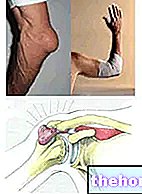The cause of osteoarthritis is unknown, so it is thought that the disease is multifactorial, that is caused by several coexisting causes. It can be stated in general that the state of joint equilibrium is maintained by a normal load exerted on a normal cartilage, therefore all the factors capable of modifying this state can be considered risk factors. The imbalance can derive from the abnormal influence of the factors that act on the load (mechanical stress, obesity, malformations, traumas and microtraumas) or on the cartilage (inflammation, genetic predisposition, disorders metabolic, aging) or both. The extent and severity of the process may also depend on the number of factors that intervene, their extent and their duration of action.
The main risk factors that predispose to the development of osteoarthritis are:
Age: changes in senile cartilage lead to a loss of elasticity and resistance to stress and favor the damaging action of other factors.
Mechanical factors: very relevant for joint balance. Joint malformations or malpositions are especially important in knee osteoarthritis, which is quite frequent in the female population, probably due to excessive use, repeated microtrauma and dislocations. Professional and sporting activities have been seen to be responsible for the onset of the disease. Among the workers there is arthrosis of the shoulders, elbows and hands in the pneumatic hammer workers, the arthrosis of the hip in professional dancers, that of the knee in miners and lumbar knee in truck or bus drivers. For sportsmen, judgment is more difficult, as there can be numerous causes at stake. In football players, for example, one of these can be the frequent rupture of the menisci. A basic weakness of the ligaments, on the other hand, can explain the "osteoarthritis of the shoulders in tennis players. Also suggestive is the observation of an" increased frequency of "arthrosis of the hands in judoists. As regards trauma, violent trauma with fracture can generate a" indirectly, due to instability or incongruity of the joint heads. However, it seems that a responsibility can also be ascribed to the bruise on the cartilage, without fracture.
Inheritance: some hereditary diseases such as hemochromatosis, Ehlers-Danlos syndrome and Marfan syndrome, impair metabolism and / or joint function and can generate some types of secondary osteoarthritis. It has long been known that arthrosis of the fingers often recognizes a family transmission.
Obesity and diseases of the endocrine system: Obesity is undoubtedly the most relevant risk factor for the development of osteoarthritis of the knee in both sexes. Instead, some doubts remain about its role in determining that of the hip, which however influences the type of evolution, aggravating it. Even some alterations of the endocrine system, such as diabetes mellitus and gout, regardless of obesity, have been called in cause as possible risk factors.
Inflammation: its role is highly valued, both for its ability to cause osteoarthritis and for the influence on its progression. In the first case, the forms of osteoarthritis deriving from arthritis, especially rheumatoid arthritis, and, in the second case, are inserted it is considered the intervention of a real inflammatory process in the joints affected by arthrosis.
Other articles on "Causes of" arthrosis "
- Arthrosis
- How does the arthritic process begin?
- Osteoarthritis: the symptoms
- Osteoarthritis: diagnosis, treatment and prevention























-nelle-carni-di-maiale.jpg)




